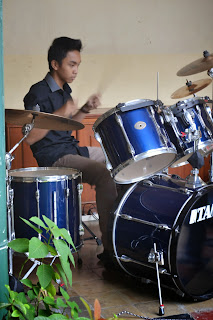Do you know what is the animal in the picture? It is a sloth. It's not one of the seven deadly sin which means laziness. But the sloth animal which is slow-moving. Sloth isn't lazy, but its slow movement that make it's named sloth.
Sloths are medium-sized mammals belonging to the families Megalonychidae (two-toed sloth) and Bradypodidae (three-toed sloth), classified into six species. They are part of the order Pilosa and are therefore related to anteaters, which sport a similar set of specialized claws. Extant sloths are arboreal (tree-dwelling) residents of the jungles of Central and South America, and are known for being slow-moving, and hence named "sloths". Extinct sloth species include a few species of aquatic sloths and many ground sloths, some of which attained the size of elephants.The sloth's taxonomic suborder is Folivora, sometimes also called Phyllophaga (Owen, 1842) or Tardigrada (Latham and Davies, 1795). The first two names both mean "leaf-eaters"; derived from Latin and Greek, respectively. Names for the animals used by tribes in Ecuador include ritto, rit, and ridette, mostly forms of the word "sleep", "eat", and "dirty" from Tagaeri tribe of Huaorani.

Sloths spend most of their lives hanging upside-down from tree branches; they eat, sleep, mate, and give birth upside-down in the trees. They hold onto tree branches with strong, curved claws that are on each of their four feet. The sloth "walk" upside-down along tree branches. They only rarely venture to the ground and walk on the ground in an upright position. Sloths spend almost all of their lives in trees; they are arboreal. These mostly-quiet mammals live in the tropical rain forests of South and Central America. Sloths can swim well too. Male sloths are solitary, shy animals. Females sometimes congregate together. Sloths are nocturnal; they are most active at night and sleep all day. They sleep about 15 to 18 hours each day, hanging upside down.

Sloths have a thick brown (and slightly-greenish) fur coat. Sloths are about the size of a cat (roughly 2 feet = 61 cm long). They have a short, flat head, big eyes, a short snout, a short or non-existent tail, long legs, and tiny ears. Sturdy, curved claws are on each foot; they use these claws to hang from trees.Sloths are hunted by jaguars, harpy eagles, and people. A sloth's main forms of protection are its camouflage (greatly increased by the coating of algae growing on its fur) and its very slow movement; these adaptations make it virtually disappear in the rain forest canopy. Colonies of green algae encrusting their fur, both adding to the camouflage effect and providing some nutrients to the sloths, who lick the algae.

Sloths are plant-eaters who are more active at night; they eat leaves (including leaves from the cecropia tree), tender young shoots, and fruit; they are herbivores (plant-eaters). It used to be thought that sloths ate mostly cecropia leaves because they were often spotted in cecropia trees. It turns out that they also live in many other trees, but aren't spotted there as easily as in cecropia trees.
Sloths have a low metabolic rate and a low body temperature (91°F). This keeps their food and water needs to a minimum. Sloths have small molars which they use to chew up their leafy food. Their stomach has many separate compartments that are used to digest the tough cellulose (a component of plant material that they eat). Adult females produce a single baby each year. They give birth upside down hanging from a tree branch. Sloths may live 10-20 years in the wild.
Did you know that Sid from Ice Age is a sloth? Yes, it's ridiculously true! Sid is an ancient sloth!

Sloths are members of the superorder Xenarthra, a group of mammals that appeared in South America about 60 million years ago (Mya), although at least one source puts the date at which sloths and related animals broke off from other placental mammals at about 100 Mya. Also included among the Xenarthra are anteaters and armadillos. The earliest xenarthrans were arboreal herbivores with sturdy spines, fused pelvises, stubby teeth, and small brains.
The living sloths belong to one of two families, known as the Megalonychidae ("two-toed" sloths) and the Bradypodidae (three-toed sloths). All living sloths have in fact three toes; the "two-toed" sloths, however, have only two fingers. Two-toed sloths are generally faster-moving than three-toed sloths. Both types tend to occupy the same forests; in most areas, one species of three-toed sloth and one species of the larger two-toed type will jointly predominate.
However, their adaptations belie the actual relationships of the living sloth genera, which are more distant from each other than their outward similarity suggests. The common ancestor of the two genera apparently lived 35–40 Mya, making the living forms stunning examples of convergent or parallel evolution. The two-toed sloths of today are far more closely related to one particular group of ground sloths than to the living three-toed sloths. Whether these ground-dwelling Megalonychidae were descended from tree-climbing ancestors or whether the two-toed sloths are really miniature ground sloths converted (or reverted) to arboreal life cannot presently be determined to satisfaction. The latter possibility seems slightly more likely, because the small ground sloths Acratocnus and Neocnus, which were also able to climb, are among the closer relatives of the two-toed sloths, and these together were related to the huge ground sloths Megalonyx and Megalocnus.
The evolutionary history of the three-toed sloths is not well known. No particularly close relatives, ground-dwelling or not, have yet been identified. The ground sloths do not constitute a monophyletic group. Rather, they make up a number of lineages, and as far as is known, until the Holocene, most sloths were in fact ground-dwellers. The famous Megatherium, for example, belonged to a lineage of ground sloths that was not very close to the living sloths and their ground-living relatives, like the small Neocnus or the massive Megalonyx. Meanwhile, Mylodon, among the last ground sloths to disappear, was only very distantly related to either of these.

Sloths belong to the:
·
Kingdom Animalia (the animals)
·
Phylum Chordata
·
Subphylum Vertebrata (animals with backbones)
·
Class Mammalia (warm-blooded animals with fur
and mammary glands)
·
Order Xenarthra
·
Suborder Pilosa
o
Family Bradypodidae
§
Genus Bradypus - Three-toed Sloths
·
Species torquatus (the maned sloth)
·
Species tridactylus (the Three-toed Sloth has
three toes (and claws) on the front and hind legs
·
Species variegatus
o
Family Megalonychidae
§
Genus Choloepus - Two-toed Sloths
·
Species hoffmanni (Hoffman's Sloth, a two-toed
sloth: it has two toes (and claws) on the front legs; the hind legs have three
toes (and claws)
·
Species didactylus (Linne's Two-Toed Sloth)
In Costa Rica, the Aviarios Sloth Sanctuary cares for "wounded and abandoned sloths. About 130 animals have been released back into the wild."
That's the things about sloth. This page is dedicated to this slow yet adorable animal. Enjoy :)
(source : http://en.wikipedia.org/wiki/Sloth
http://www.enchantedlearning.com/subjects/mammals/sloth/)


























